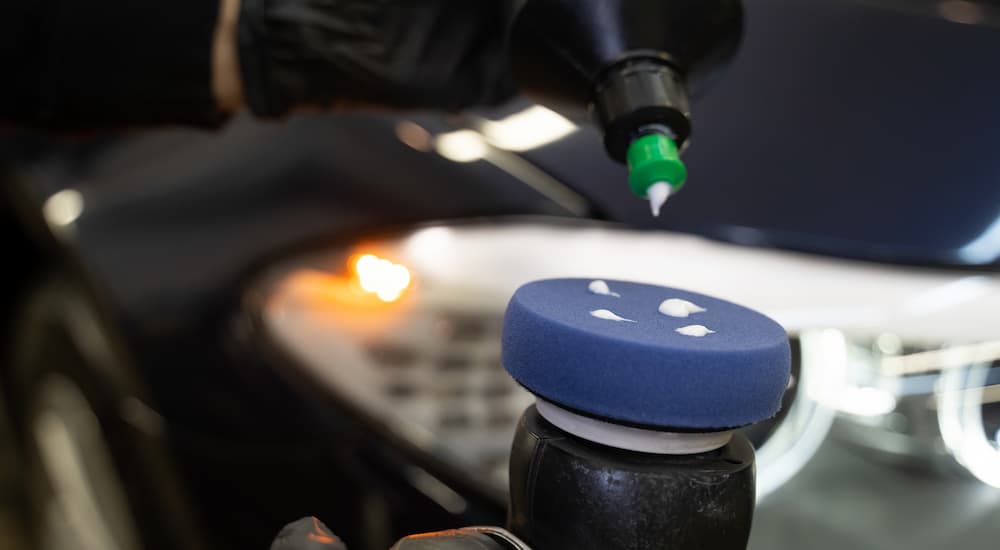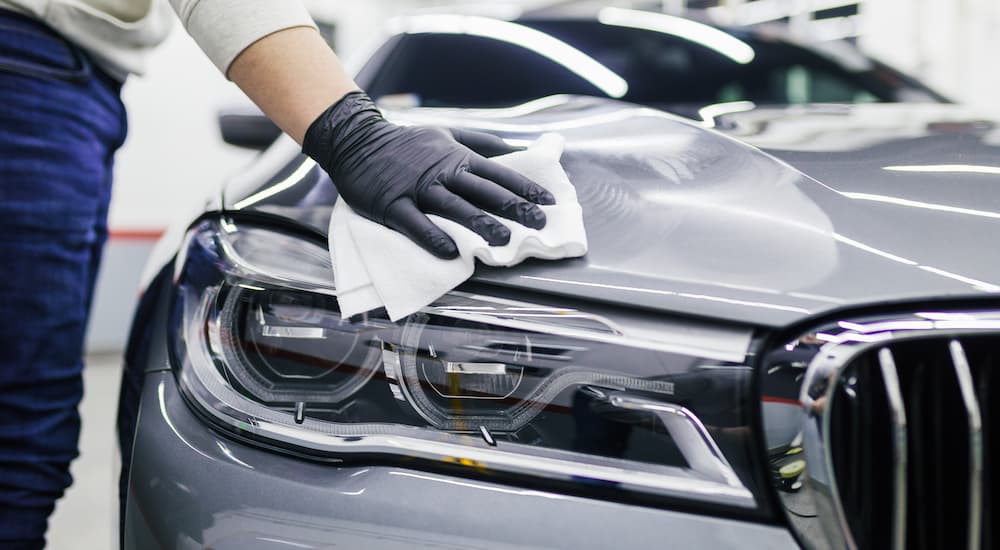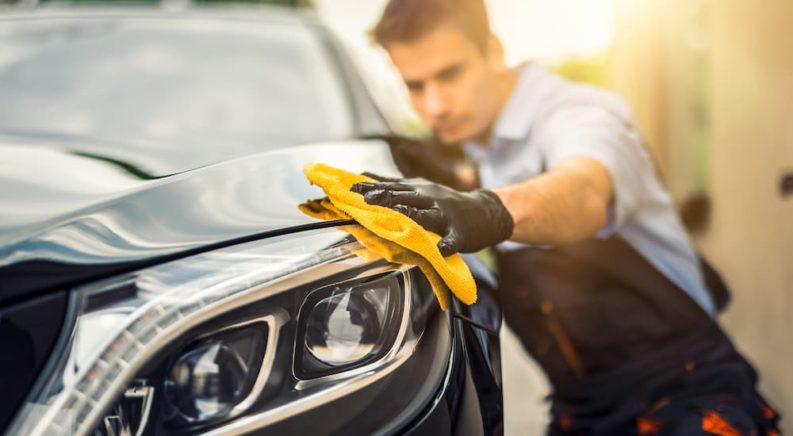Waxing a car is the first line of defense against all the dirt, grime, salt, and road debris conspiring to foul up the paint job. Getting in the habit of regular washing and waxing won’t only keep your vehicle looking its best but can also go a long way in delaying some of the inevitable corrosion that all drivers have to deal with. That said, wax has come a long way in the last few decades. While you might immediately picture that old can of wax paste used by your father and your father’s father before him, there are alternatives.
Recent innovations in synthetic waxes have seen a new generation of spray-on and liquid waxes take their place alongside the old stalwarts. Typically easier and quicker to apply than a traditional paste wax, these new options offer many advantages––and some disadvantages––when compared to the waxes of old. Join us as we take a close look at the different types of waxes, share a few tips for your next wax job and discuss the difference between car wax and options like sealants and ceramic coatings.
Wax vs Sealant vs Ceramic Coating
Wax isn’t the only option for protecting your vehicle’s exterior but it is the most affordable. Other popular options include sealants and ceramic coatings, which, while much longer-lasting than traditional car wax, are also much more expensive. Offered in both paste and spray forms, sealants are essentially a synthetic alternative to wax that stand up much better to heat, water, UV exposure, detergents, acidic substances, and other forces that can quickly wear through a traditional wax job. This type of resistance to the elements means that sealants typically only need to be applied every four to six months instead of every one to two months for traditional waxes. Naturally, that sort of longevity comes at a price, with sealant kits costing between $20 and $50 and a professional application going for as much as $150. Compare this to $15 to $30 for a DIY wax job or $50 to $100 to call in the pros, and the main advantage of wax becomes clear rather quickly.
Ceramic coating represents the most convenient, effective, and expensive option for most drivers. Offering unparalleled durability and water resistance while matching traditional wax in terms of shine, ceramic coatings, or “nano-coating,” is a silica-based liquid polymer that creates a nearly impenetrable protective layer over your vehicle’s paint job. This layer is resistant to everything but heat and abrasion, allowing it to potentially last for multiple years if properly applied. However, the application is tricky, with ceramic coating requiring a deft touch that’s not easy to master. The biggest issue comes down to prep work, with a vehicle requiring multiple hours, or even days, of laborious detailing to prepare it for the process.
For this reason, drivers often opt for professional application when it comes to ceramic coating, which ups the price by up to tenfold. While DIY ceramic coating kits can be found for around $100, a professional application can run into the thousands depending on the vehicle. That might sound prohibitively expensive for most drivers, but given the long-lasting nature of a ceramic coating, it’s not that bad of a bargain. It all comes down to how you value your time: would you rather apply a coat of wax every two months or pay for a ceramic coating job and not have to worry about your paint job for the next year and change? The choice is yours.
There are some other advantages to old-school car wax aside from its price. Most notably, wax provides some of the best shine out of the three options. Ceramic coatings come in a close second in the appearance category but, given their price, aren’t a realistic option for most drivers. Traditional car wax is formulated using natural ingredients commonly found in palm trees known as carnauba wax. Extracted from the fronds on the carnauba palm, this wax is used by the tree as a protective layer during the dry season in northern Brazil, where it thrives. This wax is then blended with other waxes like beeswax, oils, and petroleum distillates to create the car wax we all know and love.
Some car waxes offer a more natural formula while others lean heavily into the synthetic side of things, with some newer offerings throwing ingredients like synthetic resins and polymers into the mix in a bid to improve shine and hardening. Derived waxes do such a good job of improving a vehicle’s shine that they’re often used as an additive in sealants to improve their appearance.

Types of Wax
Next, let’s get into some of the different types of car wax. Wax has come a long way over the decades, and while “wax” is used as a catchall term, today’s car waxes are often broken down into three categories: paste wax, spray wax, and liquid wax. Each has its own advantages and disadvantages, which mostly come down to longevity and ease of application. Let’s take a closer look at each type and see which one best fits your own approach to car care.
Paste Wax
Longevity: two to six months
Ease of Application: Low
Starting with the granddaddy of them all, paste wax was the go-to choice for decades before newer spray and liquid formulas started showing up on the market. Paste wax is not the easiest to apply, requiring no shortage of patience and elbow grease to work it over the surface of the vehicle. Whereas spray-on and liquid waxes can be applied with a few swipes of a rag, paste wax needs to be thoroughly worked into the surface on an applicator pad, wiped in a circular pattern, allowed to dry, and then gone over once again with a polishing pad or microfiber towel. Paste wax also requires equal patience when it comes time to buff it off later down the line. That said, it is the longest-lasting option, with certain brands offering protection for as long as six months.
The choice of which type of wax to use can often come down to the current condition of your vehicle. If you’ve been keeping up on regular car washes and waxing and your paint job is in good shape, spray or liquid waxes will do just fine. If, on the other hand, you’ve been neglecting your regular automotive maintenance, few things can bring a vehicle back from the edge like a good coat of paste wax. Paste wax is usually formulated with more solvents than spray or liquid waxes, which can make all the difference when it comes to removing old stuck-on dirt and grime. It also deposits more wax over the surface of the vehicle, which can help fill in pitted surfaces and protect any areas where bare metal is exposed.
Spray Wax
Longevity: two to three weeks
Ease of Application: High
Spray wax’s primary advantage comes down to ease of application. The process requires little more than a bottle of spray wax and a microfiber towel to give it a quick wipe, unlike paste wax which must be methodically worked into the surface to do its thing. The very fact that spray wax is, by definition, sprayed over a vehicle makes it a much quicker project than paste wax, which must be applied by hand. Much like when it comes to choosing between a wax, sealant, and ceramic coating, the choice to go with a spray wax requires drivers to do some personal calculus on application time versus longevity.
While spray wax can be applied much more quickly, it also only lasts between two to three weeks––less than a quarter of the time of some paste waxes. This short lifespan has led some experts to characterize spray waxes as more of a booster product that can be applied between coats of paste wax rather than a full-on primary surface protectant. Spray waxes can serve this role quite well, refreshing a vehicle’s shine and extending its protection, but they aren’t a great option in the long term, with some products showing a noticeable decrease in performance in as little as one week.
Despite some disadvantages, spray wax can be a much easier option for those who are new to auto detailing as it doesn’t require the same level of technique as a paste wax. Liquid wax also tends to be easier on a vehicle’s paint job, which makes it a solid choice for those with newer vehicles. Of course, it doesn’t offer the same surface-rehabilitating properties of paste waxes as the liquid-based formulas can’t really fill in pitted areas or scratches as well as many paste waxes can.

Liquid Wax
Longevity: one to three months
Ease of Application: High
The differences between liquid and spray waxes can be pretty subtle, often only differing in terms of how they’re applied. Regardless, there are some important distinctions to point out, starting with longevity. Liquid waxes can last from one to three months, giving them a major advantage over spray waxes which tend to have an effective lifespan of fewer than three weeks. While still much quicker than paste wax, liquid wax can take longer to apply than spray wax because the vehicle must be completely dry before starting the process. Spray wax, on the other hand, can be applied when the vehicle is still wet following a car wash, speeding up the process and eliminating any downtime between tasks. Like spray wax, liquid wax is easier on a vehicle’s finish and doesn’t offer the same level of long-term protection when it comes to filling in pitted areas. It’s also just as easy to remove as spray wax and is ideal for drivers living in colder climates.
Wax Application and Maintenance
While application guidelines vary based on the type of wax you choose, there are a few simple rules to follow when it comes to waxing vehicles that can make a world of difference. Read on for a few of our top tips, and you’ll have your car, truck, or SUV looking showroom-fresh in no time.
Ditch the rag: While that pile of old rags in the corner of your parent’s garage might have done the trick back in his day, towel technology has come a long way since your dad busted out his first can of Turtle Wax. Microfiber clothes have become the industry’s go-to, thanks to their superior absorption. While regular cotton or polyester towels can leave dirt and grime behind on each swipe, microfiber cloths do a great job of trapping these contaminants within the fabric, making it easier to wipe them away with a single swipe without scratching the finish.
Prep the vehicle: The perfect wax job actually starts with the perfect car wash. If your vehicle isn’t clean, no amount of waxing will make much of a difference. When applying wax for the first time, it’s important to do a thorough cleaning beforehand, though the degree to which you want to obsess over this is up to you. For those looking to give their vehicle the five-star treatment, start the process by using decontamination products like iron fallout remover and tar remover. Follow this up with a pass from a clay bar, which is designed to remove harmful particles and dirt from a vehicle’s paint. After a polish, it’s finally time to apply the wax.
Choose the right car wash: Once you’ve applied the wax product of your choice, it’s important to follow up with regular washes. Aim to give your vehicle a good cleaning every two to three weeks to protect the wax job. Using the right type of car wash is another important consideration, with pH-neutral pre-washes and shampoos performing the best on a well-waxed vehicle. Some grimier vehicles might require an alkaline pre-wash to maximize results but regardless, make sure to look for products that are free from waxes or gloss enhancers.

Get shaded: While a warm, sunny day might seem like the perfect excuse to hang out in the driveway detailing your vehicle, drivers need to consider temperature and sunlight. The ideal temperature range for most waxes is between 60 to 80 degrees Fahrenheit. You shouldn’t apply car wax in direct sunlight, especially if the vehicle is too hot to comfortably touch. The sun won’t do you any favors when it comes to waxing and can actually make the paint job more prone to scratching. This is true regardless of whether you’re waxing or not, so if you want to keep your vehicle looking its best, store it inside or in the shade whenever possible.
It’s all about technique: Again, each type of car wax will have its own instructions, but there are some general tips to follow when it comes to improving your waxing technique. Make sure to apply the wax in small sections, and always start at the top of the vehicle and work your way down. Thanks to being closer to the ground, the lower surfaces of your car are usually the dirtiest, and it doesn’t pay to be dragging a gritty, dirty rag over the relatively clean parts of your vehicle. This is a good tip regardless of whether you’re washing on waxing, so take note.
Preserve Your Car’s Paint
Developing a regular waxing habit is an important part of long-term vehicle care. Regular washes keep a vehicle looking fresh and erase much of the damage it can accrue on the road, but wax plays a larger role than many drivers think. While not as long-lasting as options like sealants and ceramic coatings, wax is also much less expensive and easier to apply, making it the go-to choice for drivers trying to keep their maintenance budget to a minimum. Between traditional paste wax and newer options like spray and liquid wax, there are plenty of products on the market that make protecting your vehicle easier than ever. Technique is another important factor to consider because a rushed or poorly-executed wax job could very well end up being worse than no wax job. At the bare minimum, make sure to apply wax every few months, and you’ll likely end up spending far less on paint touch-ups and corrosion-related repairs down the line.

